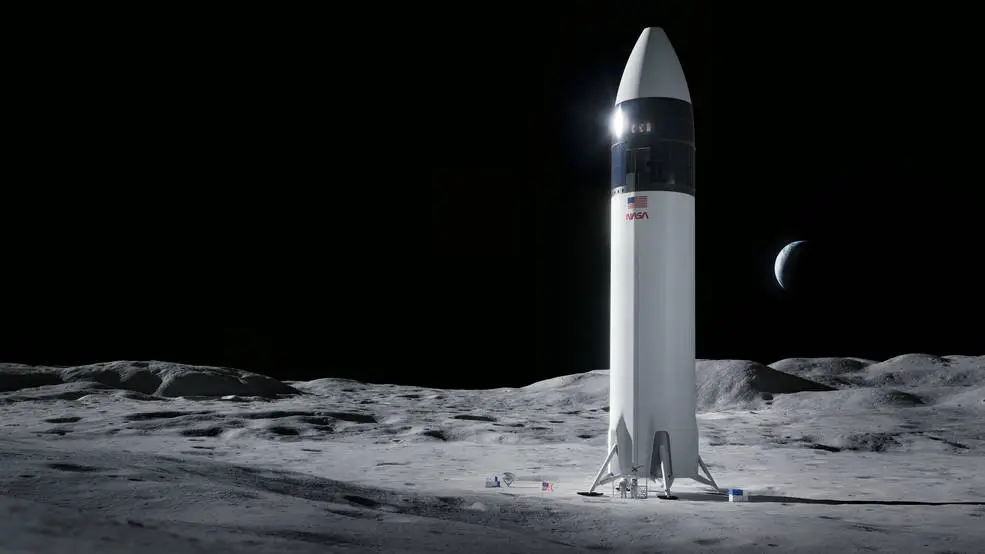‘New Kind of Partnership’ Emerges in Trump’s Plan To Lead a ‘Second Space Race’ to the Moon and Beyond
As China and Russia race to stake their claim, America is bidding to get ahead through a fusion of federal funding and corporate ambition.

The Trump administration’s push to fast-track a small nuclear power plant on the moon may sound like the stuff of science fiction or a smart political play. Beneath the spectacle, though, lies a state-led effort for technological ambition, propelled by private industry.
On Tuesday, NASA’s interim administrator Sean Duffy declared in a press conference that the agency should be ready to launch a 100-kilowatt nuclear reactor to the moon by late 2029, ahead of China and Russia. This plan builds upon years of work on small, lightweight fission systems to provide sustained power in extreme lunar conditions — which is key to supporting long-term infrastructure and ensuring the survival of equipment and astronauts during the moon’s 14-day nights, when temperatures near -300°F and solar power fails.
“This is crucial for developing a space logistics system,” a professor of space security at Johns Hopkins University, Namrata Goswami, tells the Sun. “If the U.S. truly aims to build a large-scale lunar base, power is the most vital requirement.” She notes: “China operates the largest nuclear reactors on Earth (102), giving it extensive experience in nuclear power development.”
This ambitious goal is poised to reinvigorate the public-private partnership model that enabled the U.S. government to execute bold scientific agendas in the 20th century. Companies like Lockheed Martin, Westinghouse, and Intuitive Machines have already received contracts through NASA and the Department of Energy to develop prototype lunar reactors. These firms compete for contracts, but also invest their own resources in R&D, giving them financial skin in the game. SpaceX is a key partner in NASA’s Artemis program, which is slated to launch its first crewed mission around the moon in September and land humans on the lunar surface in mid-2027.
The U.S. government has historically relied on private industry to execute bold scientific agendas in moments of great power competition. The Manhattan Project, though directed by the U.S. Army Corps of Engineers, depended on industrial giants like DuPont and Westinghouse to build and operate weapons infrastructure. The Apollo Program that sent man to the moon more than fifty years ago involved over 20,000 private companies; while NASA led the mission, a range of companies including Northrop Grumman, Boeing, and IBM built the rockets, computers, and systems.
In recent decades, however, that model gave way to a more laissez-faire posture. Mission-driven science lost momentum in favor of more incremental innovation driven by market needs. U.S. space policy shifted from pioneering exploration to maintenance and low-Earth orbit operations. “The state has retreated from the pursuit of the kind of large-scale breakthroughs that gave rise to the atomic bomb and the internet,” the chief executive of Palantir, Alex Karp, writes in The Technological Republic. “Silicon Valley, meanwhile, turned inward, focusing its energy on narrow consumer products, rather than projects that speak to and address our greater security and welfare.”
The Trump administration appears eager to reverse that trend. With China investing heavily in space and nuclear energy, a techno-nationalist agenda is taking root in Washington, one that seeks to dismiss cautious bureaucratic planning in favor of high-risk, high-reward programs that put defense and energy contractors at the helm.
The new lunar nuclear initiative offers a chance to use new technology that didn’t exist at the dawn of the nuclear age, the deputy director of the Aerospace Security Project, Clayton Swope, at the Center for Strategic and International Studies tells the Sun. NASA could take an approach that opens the door for private companies not just to pursue government-backed R&D or build hardware for NASA, but to operate lunar power utility and sell energy as a service — much like the model NASA now uses with commercial firms for FedEX-style transport to the ISS and the moon. American companies interested in this kind of arrangement could range from industry giants like Lockheed Martin to smaller, VC-backed startups eyeing nuclear power as the next big frontier.
“It’s a new kind of partnership,” Mr. Swope says. “The government says, ‘we need this,’ and companies say, ‘here’s what we can do.’ Then NASA picks the best path forward.” This commercial approach, if it comes to fruition, would mark a shift from wartime innovation of the past and follow the trend of how NASA is doing more of its work today: turning to companies for their best ideas and using those ideas to shape its strategy. This competitive model empowers the government to build faster and opens up opportunities for economic growth.
“That’s the beauty of how NASA is doing business these days and of the American system: you have an ecosystem of innovation, where companies can come to the table and say, ‘I have a good idea,’” Mr. Swope says. “You’re not going to see that in China and Russia, which have a top-down approach to the same problem.”
Critics argue that NASA’s push for nuclear power for the moon could divert attention and resources from its core science programs. The plan “threatens to siphon funds from other essential services” and “provides a blueprint and justification for dismantling and defunding NASA science,” astrophysicist and science writer Ethan Siegel claims.
That concern has gained traction in light of the Trump administration’s 2026 budget proposal, which would slash NASA’s funding from $24.8 billion to $18.8 billion, the agency’s lowest level since 1961 when adjusted for inflation. It also calls for a workforce reduction of one-fifth and the cancellation or phase-out of high-profile science missions such as the Mars Sample Return mission. All changes are pending Congressional approval. In an open letter in May, representatives of NASA’s advisory groups decried the cuts, warning that the US “will cede this position of leadership to other nations, such as China.”
Yet as some sources of funding shrink, the government’s 2026 budget includes a surge in spending on human space exploration. More than $7 billion will be allocated for lunar missions and $1 billion for Mars initiatives. Unprecedented resources are also being thrown toward space defense: the recently passed “One Big Beautiful Bill” allocates nearly $40 billion to the U.S. Space Force and $25 billion toward building a new “Golden Dome” missile defense shield. “The budget ensures America’s human space exploration efforts remain unparalleled, innovative, and efficient,” the agency said in a statement.
Time is of the essence. China and Russia are jointly developing a lunar reactor they aim to deploy by 2035. If they get there first, they “could potentially declare a keep-out zone” that would limit American operations on the moon, Mr. Duffy said. US officials have also expressed concerns over Chinese space programs’ ties with the People’s Liberation Army, fearing that Beijing could potentially use the moon base to conduct space warfare including targeting U.S. satellite systems.
America might no longer be in the golden age of space exploration, but in Mr. Duffy’s words, the nation is now locked in a “second space race” with yet another rival overseas. The imperative to win this moonshot is just as pressing. “If we’re going to engage in the race to the moon and the race to Mars,” Mr. Duffy said, “we have to get our act together.”

